HD 145377 is a star in the southern constellation Scorpius. It has an apparent visual magnitude of 8.10 and can be viewed with a small telescope. The star is located at a distance of 175 light years from the Sun based on parallax, and it is drifting further away with a radial velocity of +11.6. The absolute magnitude of this star is 4.31, indicating it would be visible to the naked eye if it were at a distance of 10 parsecs.

WR 22, also known as V429 Carinae or HR 4188, is an eclipsing binary star system in the constellation Carina. The system contains a Wolf-Rayet (WR) star that is one of the most massive and most luminous stars known, and is also a bright X-ray source due to colliding winds with a less massive O class companion. Its eclipsing nature and apparent magnitude make it very useful for constraining the properties of luminous hydrogen-rich WR stars.

ζ Coronae Borealis, Latinised as Zeta Coronae Borealis, is the Bayer designation of a double star in the constellation Corona Borealis. The two components are separated by six arc-seconds and share the same Hipparcos catalogue number and Flamsteed designation. Each of the two is also a spectroscopic multiple system, with a total of five stars in the group.
HD 256 is a binary star system in the equatorial constellation of Cetus. It has a white hue and is dimly visible to the naked eye with an apparent visual magnitude of 6.20. Based upon parallax measurements, the system is located at a distance of approximately 474 light years from the Sun. It is drifting closer with a radial velocity of −10 km/s.

V1191 Cygni is the variable star designation for an overcontact binary star system in the constellation Cygnus. First found to be variable in 1965, it is a W Ursae Majoris variable with a maximum apparent magnitude 10.82. It drops by 0.33 magnitudes during primary eclipses with a period of 0.3134 days, while dropping by 0.29 magnitudes during secondary eclipses. The primary star, which is also the cooler star, appears to have a spectral type of F6V, while the secondary is slightly cooler with a spectral type of G5V. With a mass of 1.29 solar masses and a luminosity of 2.71 solar luminosities, it is slightly more massive and luminous than the sun, while the secondary is only around 1/10 as massive and less than half as luminous. With a separation of 2.20 solar radii, the mass transfer of about 2×10−7 solar masses per year from the secondary to the primary is one of the highest known for a system of its type.

HP Lyrae is a variable star in the constellation Lyra, with a visual magnitude varying between 10.2 and 10.8. It is likely to be an RV Tauri variable, an unstable post-AGB star losing mass before becoming a white dwarf.

WR 9 is a spectroscopic binary in the constellation Puppis consisting of a Wolf-Rayet star and a class O star. It is around 12,000 light years away.

LQ Andromedae is a variable star in the constellation Andromeda. Its maximum apparent visual magnitude is 6.5, placing it at the limit of the visibility to the naked eye. The brightness, however, drops down to 6.66 with a periodic cycle of roughly 7.44 hours.
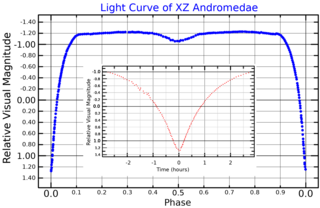
XZ Andromedae is a binary star in the constellation Andromeda. Its maximum apparent visual magnitude is 9.91, but drops down to 12.45 every 1.357 days. Its variability matches the behaviour of Algol variable stars.

AB Andromedae is a binary star in the constellation Andromeda. Paul Guthnick and Richard Prager discovered that the star is an eclipsing binary in 1927. Its maximum apparent visual magnitude is 9.49 but shows a variation in brightness down to a magnitude of 10.46 in a periodic cycle of roughly 8 hours. The observed variability is typical of W Ursae Majoris variable stars, so the two stars in this system form a contact binary.

AD Andromedae is an eclipsing binary in the constellation Andromeda. Its maximum apparent visual magnitude is 11.2, but it shows a decrease of 0.62 magnitudes during the main eclipse and 0.58 during the secondary one. It is classified as a Beta Lyrae variable star with a period of almost one day.

BX Andromedae is an eclipsing binary star in the constellation Andromeda. Its maximum apparent visual magnitude is 8.87. Within a cycle of approximately 14.6 hours, the brightness drops down to a magnitude of 9.53 during the main eclipse, and to a magnitude of 9.12 during the secondary one. It is classified as a Beta Lyrae variable.
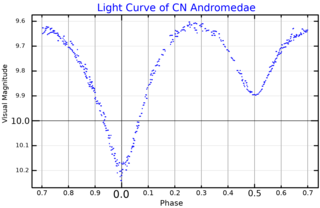
CN Andromedae is an eclipsing binary star in the constellation Andromeda. Its maximum apparent visual magnitude is 9.62 and drops down to a minimum of 10.2 during the main eclipse. It is classified as a Beta Lyrae variable with a period roughly of 0.4628 days.
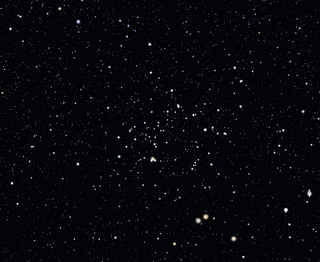
DS Andromedae is an eclipsing binary star in the constellation Andromeda and a member of the open cluster NGC 752. Its maximum apparent visual magnitude is 10.44, but drops down to 10.93 during the main eclipse and to 10.71 during the secondary one.
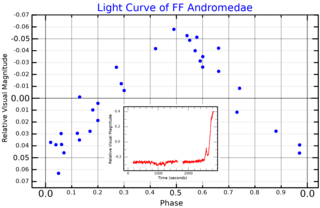
FF Andromedae is a spectroscopic binary in the constellation Andromeda. It has a typical apparent visual magnitude of 10.4, but undergoes flare events that can increase its brightness by about a magnitude.

HN Andromedae is a variable star in the constellation Andromeda. Its apparent visual magnitude varies between 6.67 and 6.76 in a cycle of 69.51 days. It is classified as an α2 Canum Venaticorum variable.
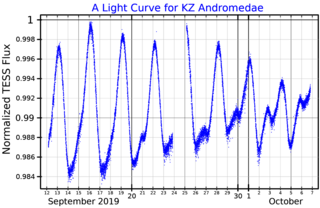
KZ Andromedae is a double lined spectroscopic binary in the constellation Andromeda. Its apparent visual magnitude varies between 7.91 and 8.03 during a cycle slightly longer than 3 days.

QR Andromedae is an eclipsing binary star in the constellation Andromeda. Its maximum apparent visual magnitude is 12.16, but its light curve shows clearly eclipsing events where its brightness can drop to a magnitude of 13.07. This leads to its classification as an Algol variable star.
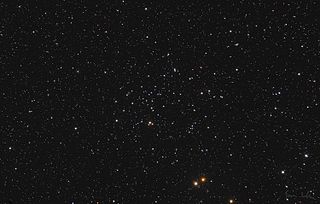
QX Andromedae is an eclipsing binary in the constellation Andromeda. It varies from a maximum apparent visual magnitude of 11.28 to a minimum of 11.50. Since it is impossible to specify the onset time of the eclipses, it is classified as a W Ursae Majoris variable star. It is also observed as an X-ray source and is a member of the open cluster NGC 752.

V455 Andromedae is a dwarf nova in the constellation Andromeda. It has a typical apparent visual magnitude of 16.5, but reached a magnitude of 8.5 during the only observed outburst.


















